Low-Dose Radiation Affects Cardiovascular Disease Risk in Human Aortic Endothelial Cells by Altering Gene Expression under Normal and Diabetic Conditions
Abstract
:1. Introduction
2. Results
2.1. Human Aortic Endothelial Cell Function Was Impaired in Type 2 Diabetes Mellitus Compared to That in Normal Conditions
2.2. Gene Profiling of HAECs after 100 mGy Ionizing Radiation Treatment
2.3. Gene Profiling in T2D-HAECs after Treatment with 100 mGy of Ionizing Radiation
2.4. Regulation of Cell Function Following Response to Low-Dose Radiation in ECs under Normal and Diabetic Conditions
3. Discussion
4. Materials and Methods
4.1. Cell Culture
4.2. Irradiation
4.3. MTT Assay
4.4. Tube Formation Assay
4.5. Senescence-Associated β-Galactosidase (SA-β-gal) Staining
4.6. Western Blotting
4.7. RNA Isolation
4.8. RNA-seq
4.9. Identification of DEGs and Data Analysis
4.10. Heatmap Visualization and Hierarchical Clustering Analysis
4.11. Pathway Analysis
4.12. Gene Ontology (GO) Analysis
4.13. Protein–Protein Interaction Network and Module Analysis
4.14. Total RNA Extraction and Quantitative Reverse Transcription-Polymerase Chain Reaction (qRT-PCR)
4.15. Statistical Analysis
Supplementary Materials
Author Contributions
Funding
Institutional Review Board Statement
Informed Consent Statement
Data Availability Statement
Conflicts of Interest
References
- Brenner, D.J.; Doll, R.; Goodhead, D.T.; Hall, E.J.; Land, C.E.; Little, J.B.; Lubin, J.H.; Preston, D.L.; Preston, R.J.; Puskin, J.S.; et al. Cancer risks attributable to low doses of ionizing radiation: Assessing what we really know. Proc. Natl. Acad. Sci. USA 2003, 100, 13761–13766. [Google Scholar] [CrossRef] [PubMed] [Green Version]
- Valentin, J. The 2007 Recommendations of the International Commission on Radiological Protection; Elsevier: Amsterdam, The Netherlands, 2007; Volume 37, pp. 1–332. [Google Scholar]
- Wrixon, A.D. New ICRP recommendations. J. Radiol. Prot. 2008, 28, 161–168. [Google Scholar] [CrossRef] [PubMed]
- Fazel, R.; Krumholz, H.M.; Wang, Y.; Ross, J.S.; Chen, J.; Ting, H.H.; Shah, N.D.; Nasir, K.; Einstein, A.J.; Nallamothu, B.K. Exposure to low-dose ionizing radiation from medical imaging procedures. N. Engl. J. Med. 2009, 361, 849–857. [Google Scholar] [CrossRef] [PubMed] [Green Version]
- Little, M.P.; Lipshultz, S.E. Low dose radiation and circulatory diseases: A brief narrative review. Cardiooncology 2015, 1, 4. [Google Scholar] [CrossRef] [Green Version]
- Alexander, Y.; Osto, E.; Schmidt-Trucksass, A.; Shechter, M.; Trifunovic, D.; Duncker, D.J.; Aboyans, V.; Back, M.; Badimon, L.; Cosentino, F.; et al. Endothelial function in cardiovascular medicine: A consensus paper of the European Society of Cardiology Working Groups on Atherosclerosis and Vascular Biology, Aorta and Peripheral Vascular Diseases, Coronary Pathophysiology and Microcirculation, and Thrombosis. Cardiovasc. Res. 2021, 117, 29–42. [Google Scholar] [PubMed] [Green Version]
- Leon, B.M.; Maddox, T.M. Diabetes and cardiovascular disease: Epidemiology, biological mechanisms, treatment recommendations and future research. World J. Diabetes 2015, 6, 1246–1258. [Google Scholar] [CrossRef] [PubMed]
- Naveed, A.; Farrukh, L.; Sana, M.K.; Naveed, B.; Randhawa, F.A. Pharmacological Primary Prevention of Diabetes Mellitus Type II: A Narrative Review. Cureus 2020, 12, e10033. [Google Scholar] [CrossRef]
- Teinturier, C.; Tournade, M.F.; Caillat-Zucman, S.; Boitard, C.; Amoura, Z.; Bougneres, P.F.; Timsit, J. Diabetes mellitus after abdominal radiation therapy. Lancet 1995, 346, 633–634. [Google Scholar] [CrossRef]
- Meacham, L.R.; Sklar, C.A.; Li, S.; Liu, Q.; Gimpel, N.; Yasui, Y.; Whitton, J.A.; Stovall, M.; Robison, L.L.; Oeffinger, K.C. Diabetes mellitus in long-term survivors of childhood cancer. Increased risk associated with radiation therapy: A report for the childhood cancer survivor study. Arch. Intern. Med. 2009, 169, 1381–1388. [Google Scholar] [CrossRef] [Green Version]
- Rose, S.R.; Horne, V.E.; Howell, J.; Lawson, S.A.; Rutter, M.M.; Trotman, G.E.; Corathers, S.D. Late endocrine effects of childhood cancer. Nat. Rev. Endocrinol. 2016, 12, 319–336. [Google Scholar] [CrossRef]
- Friedman, D.N.; Tonorezos, E.S.; Cohen, P. Diabetes and Metabolic Syndrome in Survivors of Childhood Cancer. Horm. Res. Paediatr. 2019, 91, 118–127. [Google Scholar] [CrossRef] [PubMed]
- Poonsombudlert, K.; Limpruttidham, N. Total Body Irradiation and Risk of Diabetes Mellitus; A Meta-Analysis. Asian Pac. J. Cancer Prev. 2019, 20, 885–891. [Google Scholar] [CrossRef] [PubMed]
- Barnea, D.; Raghunathan, N.; Friedman, D.N.; Tonorezos, E.S. Obesity and Metabolic Disease After Childhood Cancer. Oncology 2015, 29, 849–855. [Google Scholar] [PubMed]
- Meacham, L.R.; Chow, E.J.; Ness, K.K.; Kamdar, K.Y.; Chen, Y.; Yasui, Y.; Oeffinger, K.C.; Sklar, C.A.; Robison, L.L.; Mertens, A.C. Cardiovascular risk factors in adult survivors of pediatric cancer—A report from the childhood cancer survivor study. Cancer Epidemiol. Biomark. Prev. 2010, 19, 170–181. [Google Scholar] [CrossRef] [PubMed] [Green Version]
- Tatsukawa, Y.; Cordova, K.; Yamada, M.; Ohishi, W.; Imaizumi, M.; Hida, A.; Sposto, R.; Sakata, R.; Fujiwara, S.; Nakanishi, S.; et al. Incidence of Diabetes in the Atomic Bomb Survivors: 1969–2015. J. Clin. Endocrinol. Metab. 2022, 107, e2148–e2155. [Google Scholar] [CrossRef]
- Zhang, F.; Lin, X.; Yu, L.; Li, W.; Qian, D.; Cheng, P.; He, L.; Yang, H.; Zhang, C. Low-dose radiation prevents type 1 diabetes-induced cardiomyopathy via activation of AKT mediated anti-apoptotic and anti-oxidant effects. J. Cell Mol. Med. 2016, 20, 1352–1366. [Google Scholar] [CrossRef] [PubMed] [Green Version]
- Zhang, C.; Jin, S.; Guo, W.; Li, C.; Li, X.; Rane, M.J.; Wang, G.; Cai, L. Attenuation of diabetes-induced cardiac inflammation and pathological remodeling by low-dose radiation. Radiat. Res. 2011, 175, 307–321. [Google Scholar] [CrossRef]
- Wang, G.J.; Li, X.K.; Sakai, K.; Lu, C. Low-dose radiation and its clinical implications: Diabetes. Hum. Exp. Toxicol. 2008, 27, 135–142. [Google Scholar] [CrossRef] [PubMed]
- Hadi, H.A.; Suwaidi, J.A. Endothelial dysfunction in diabetes mellitus. Vasc. Health Risk Manag. 2007, 3, 853–876. [Google Scholar]
- Cai, S.; Khoo, J.; Mussa, S.; Alp, N.J.; Channon, K.M. Endothelial nitric oxide synthase dysfunction in diabetic mice: Importance of tetrahydrobiopterin in eNOS dimerisation. Diabetologia 2005, 48, 1933–1940. [Google Scholar] [CrossRef] [Green Version]
- Cutiongco, M.F.A.; Chua, B.M.X.; Neo, D.J.H.; Rizwan, M.; Yim, E.K.F. Functional differences between healthy and diabetic endothelial cells on topographical cues. Biomaterials 2018, 153, 70–84. [Google Scholar] [CrossRef] [PubMed]
- Zhu, D.D.; Tang, R.N.; Lv, L.L.; Wen, Y.; Liu, H.; Zhang, X.L.; Ma, K.L.; Liu, B.C. Interleukin-1beta mediates high glucose induced phenotypic transition in human aortic endothelial cells. Cardiovasc. Diabetol. 2016, 15, 42. [Google Scholar] [CrossRef] [PubMed] [Green Version]
- Chen, J.; Huang, X.; Halicka, D.; Brodsky, S.; Avram, A.; Eskander, J.; Bloomgarden, N.A.; Darzynkiewicz, Z.; Goligorsky, M.S. Contribution of p16INK4a and p21CIP1 pathways to induction of premature senescence of human endothelial cells: Permissive role of p53. Am. J. Physiol. Heart Circ. Physiol. 2006, 290, H1575–H1586. [Google Scholar] [CrossRef] [PubMed] [Green Version]
- Nemet, A.Y.; Vinker, S.; Levartovsky, S.; Kaiserman, I. Is cataract associated with cardiovascular morbidity? Eye 2010, 24, 1352–1358. [Google Scholar] [CrossRef] [PubMed] [Green Version]
- Shimizu, Y.; Kodama, K.; Nishi, N.; Kasagi, F.; Suyama, A.; Soda, M.; Grant, E.J.; Sugiyama, H.; Sakata, R.; Moriwaki, H.; et al. Radiation exposure and circulatory disease risk: Hiroshima and Nagasaki atomic bomb survivor data, 1950–2003. BMJ 2010, 340, b5349. [Google Scholar] [CrossRef] [PubMed] [Green Version]
- Kreuzer, M.; Auvinen, A.; Cardis, E.; Hall, J.; Jourdain, J.R.; Laurier, D.; Little, M.P.; Peters, A.; Raj, K.; Russell, N.S.; et al. Low-dose ionising radiation and cardiovascular diseases--Strategies for molecular epidemiological studies in Europe. Mutat. Res. Rev. Mutat. Res. 2015, 764, 90–100. [Google Scholar] [CrossRef] [PubMed]
- Dong, G.; Qu, L.; Gong, X.; Pang, B.; Yan, W.; Wei, J. Effect of Social Factors and the Natural Environment on the Etiology and Pathogenesis of Diabetes Mellitus. Int. J. Endocrinol. 2019, 2019, 8749291. [Google Scholar] [CrossRef] [Green Version]
- Wang, Q.Q.; Yin, G.; Huang, J.R.; Xi, S.J.; Qian, F.; Lee, R.X.; Peng, X.C.; Tang, F.R. Ionizing Radiation-Induced Brain Cell Aging and the Potential Underlying Molecular Mechanisms. Cells 2021, 10, 3570. [Google Scholar] [CrossRef]
- Pernow, J.; Jung, C. The Emerging Role of Arginase in Endothelial Dysfunction in Diabetes. Curr. Vasc. Pharmacol. 2016, 14, 155–162. [Google Scholar] [CrossRef]
- Vieira Dias, J.; Gloaguen, C.; Kereselidze, D.; Manens, L.; Tack, K.; Ebrahimian, T.G. Gamma Low-Dose-Rate Ionizing Radiation Stimulates Adaptive Functional and Molecular Response in Human Aortic Endothelial Cells in a Threshold-, Dose-, and Dose Rate-Dependent Manner. Dose Response 2018, 16, 1559325818755238. [Google Scholar] [CrossRef] [Green Version]
- Takehara, Y.; Yamaoka, K.; Hiraki, Y.; Yoshioka, T.; Utsumi, K. Protection against alloxan diabetes by low-dose 60Co gamma irradiation before alloxan administration. Physiol. Chem. Phys. Med. NMR 1995, 27, 149–159. [Google Scholar] [PubMed]
- Rombouts, C.; Aerts, A.; Beck, M.; De Vos, W.H.; Van Oostveldt, P.; Benotmane, M.A.; Baatout, S. Differential response to acute low dose radiation in primary and immortalized endothelial cells. Int. J. Radiat. Biol. 2013, 89, 841–850. [Google Scholar] [CrossRef] [PubMed]
- De Rosa, S.; Arcidiacono, B.; Chiefari, E.; Brunetti, A.; Indolfi, C.; Foti, D.P. Type 2 Diabetes Mellitus and Cardiovascular Disease: Genetic and Epigenetic Links. Front. Endocrinol. 2018, 9, 2. [Google Scholar] [CrossRef] [PubMed]
- Boshuizen, M.C.; de Winther, M.P. Interferons as Essential Modulators of Atherosclerosis. Arter. Thromb. Vasc. Biol. 2015, 35, 1579–1588. [Google Scholar] [CrossRef] [Green Version]
- Wu, X.M.; Zhang, J.; Li, P.W.; Hu, Y.W.; Cao, L.; Ouyang, S.; Bi, Y.H.; Nie, P.; Chang, M.X. NOD1 Promotes Antiviral Signaling by Binding Viral RNA and Regulating the Interaction of MDA5 and MAVS. J. Immunol. 2020, 204, 2216–2231. [Google Scholar] [CrossRef]
- Liu, G.; Lee, J.H.; Parker, Z.M.; Acharya, D.; Chiang, J.J.; van Gent, M.; Riedl, W.; Davis-Gardner, M.E.; Wies, E.; Chiang, C.; et al. ISG15-dependent activation of the sensor MDA5 is antagonized by the SARS-CoV-2 papain-like protease to evade host innate immunity. Nat. Microbiol. 2021, 6, 467–478. [Google Scholar] [CrossRef]
- Filippi, C.M.; von Herrath, M.G. Viral trigger for type 1 diabetes: Pros and cons. Diabetes 2008, 57, 2863–2871. [Google Scholar] [CrossRef] [Green Version]
- Chen, C.; Tian, J.; He, Z.; Xiong, W.; He, Y.; Liu, S. Identified Three Interferon Induced Proteins as Novel Biomarkers of Human Ischemic Cardiomyopathy. Int. J. Mol. Sci. 2021, 22, 13116. [Google Scholar] [CrossRef]
- Jian, D.; Wang, W.; Zhou, X.; Jia, Z.; Wang, J.; Yang, M.; Zhao, W.; Jiang, Z.; Hu, X.; Zhu, J. Interferon-induced protein 35 inhibits endothelial cell proliferation, migration and re-endothelialization of injured arteries by inhibiting the nuclear factor-kappa B pathway. Acta Physiol. 2018, 223, e13037. [Google Scholar] [CrossRef]
- Malakhova, O.A.; Kim, K.I.; Luo, J.K.; Zou, W.; Kumar, K.G.; Fuchs, S.Y.; Shuai, K.; Zhang, D.E. UBP43 is a novel regulator of interferon signaling independent of its ISG15 isopeptidase activity. EMBO J. 2006, 25, 2358–2367. [Google Scholar] [CrossRef]
- Rahnefeld, A.; Klingel, K.; Schuermann, A.; Diny, N.L.; Althof, N.; Lindner, A.; Bleienheuft, P.; Savvatis, K.; Respondek, D.; Opitz, E.; et al. Ubiquitin-like protein ISG15 (interferon-stimulated gene of 15 kDa) in host defense against heart failure in a mouse model of virus-induced cardiomyopathy. Circulation 2014, 130, 1589–1600. [Google Scholar] [CrossRef] [PubMed] [Green Version]
- Lai, J.H.; Hung, L.F.; Huang, C.Y.; Wu, D.W.; Wu, C.H.; Ho, L.J. Mitochondrial protein CMPK2 regulates IFN alpha-enhanced foam cell formation, potentially contributing to premature atherosclerosis in SLE. Arthritis Res. Ther. 2021, 23, 120. [Google Scholar] [CrossRef] [PubMed]
- Chmielewski, S.; Piaszyk-Borychowska, A.; Wesoly, J.; Bluyssen, H.A. STAT1 and IRF8 in Vascular Inflammation and Cardiovascular Disease: Diagnostic and Therapeutic Potential. Int. Rev. Immunol. 2016, 35, 434–454. [Google Scholar] [CrossRef] [PubMed]
- Groblewska, M.; Litman-Zawadzka, A.; Mroczko, B. The Role of Selected Chemokines and Their Receptors in the Development of Gliomas. Int. J. Mol. Sci. 2020, 21, 3704. [Google Scholar] [CrossRef]
- Gosling, J.; Dairaghi, D.J.; Wang, Y.; Hanley, M.; Talbot, D.; Miao, Z.; Schall, T.J. Cutting edge: Identification of a novel chemokine receptor that binds dendritic cell- and T cell-active chemokines including ELC, SLC, and TECK. J. Immunol. 2000, 164, 2851–2856. [Google Scholar] [CrossRef] [PubMed] [Green Version]
- Watts, A.O.; Verkaar, F.; van der Lee, M.M.; Timmerman, C.A.; Kuijer, M.; van Offenbeek, J.; van Lith, L.H.; Smit, M.J.; Leurs, R.; Zaman, G.J.; et al. beta-Arrestin recruitment and G protein signaling by the atypical human chemokine decoy receptor CCX-CKR. J. Biol. Chem. 2013, 288, 7169–7181. [Google Scholar] [CrossRef] [PubMed] [Green Version]
- Vinet, J.; van Zwam, M.; Dijkstra, I.M.; Brouwer, N.; van Weering, H.R.; Watts, A.; Meijer, M.; Fokkens, M.R.; Kannan, V.; Verzijl, D.; et al. Inhibition of CXCR3-mediated chemotaxis by the human chemokine receptor-like protein CCX-CKR. Br. J. Pharmacol. 2013, 168, 1375–1387. [Google Scholar] [CrossRef] [Green Version]
- Patel, P.A.; Tilley, D.G.; Rockman, H.A. Beta-arrestin-mediated signaling in the heart. Circ. J. 2008, 72, 1725–1729. [Google Scholar] [CrossRef] [PubMed] [Green Version]
- Feng, L.; Chen, Y.; Xu, K.; Li, Y.; Riaz, F.; Lu, K.; Chen, Q.; Du, X.; Wu, L.; Cao, D.; et al. Cholesterol-induced leucine aminopeptidase 3 (LAP3) upregulation inhibits cell autophagy in pathogenesis of NAFLD. Aging 2022, 14, 3259–3275. [Google Scholar] [CrossRef]
- Lonardo, A.; Nascimbeni, F.; Mantovani, A.; Targher, G. Hypertension, diabetes, atherosclerosis and NASH: Cause or consequence? J. Hepatol. 2018, 68, 335–352. [Google Scholar] [CrossRef]
- Kaushik, N.; Kim, M.J.; Kim, R.K.; Kumar Kaushik, N.; Seong, K.M.; Nam, S.Y.; Lee, S.J. Low-dose radiation decreases tumor progression via the inhibition of the JAK1/STAT3 signaling axis in breast cancer cell lines. Sci. Rep. 2017, 7, 43361. [Google Scholar] [CrossRef] [PubMed] [Green Version]
- Langmead, B.; Salzberg, S.L. Fast gapped-read alignment with Bowtie 2. Nat. Methods 2012, 9, 357–359. [Google Scholar] [CrossRef] [PubMed] [Green Version]
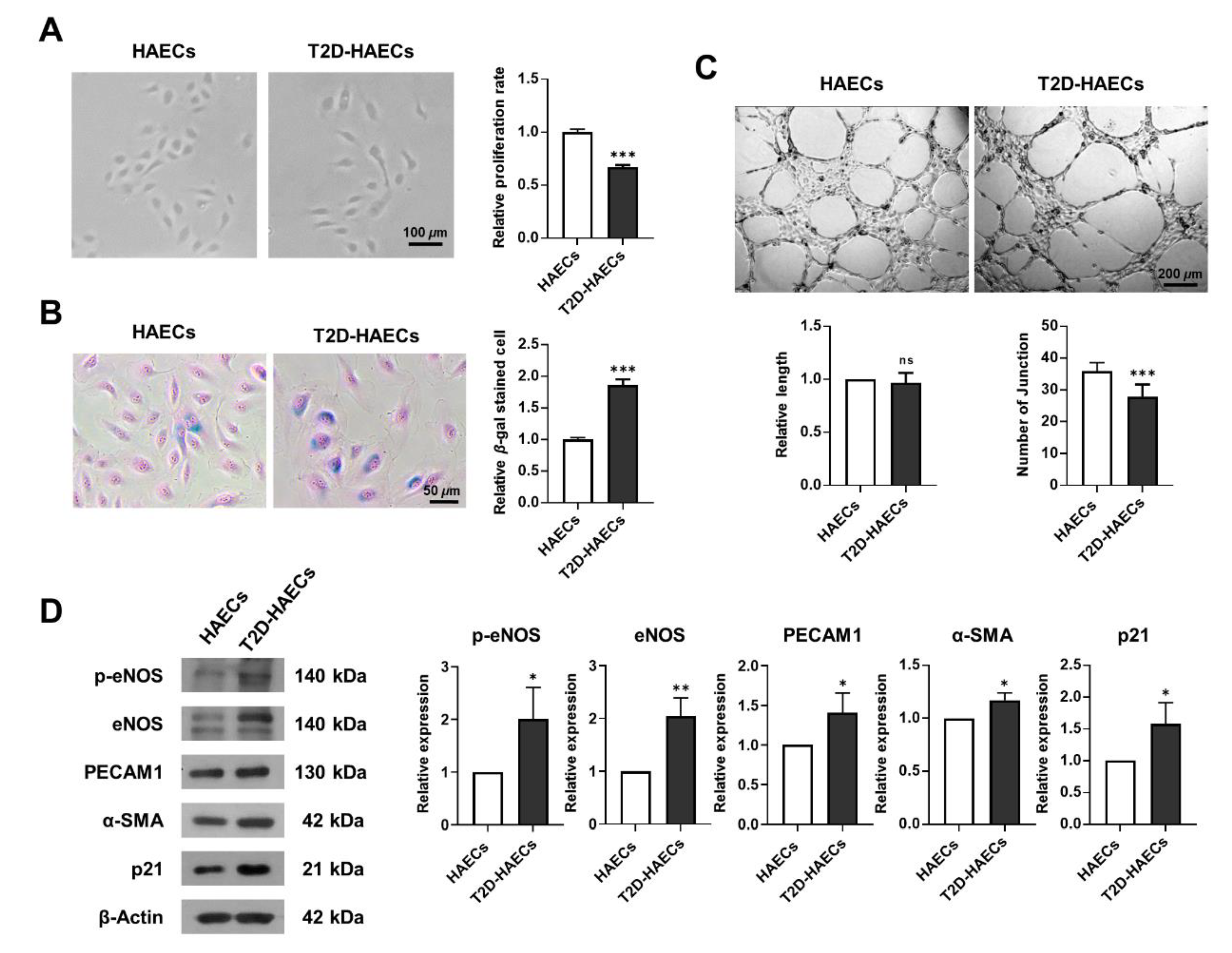

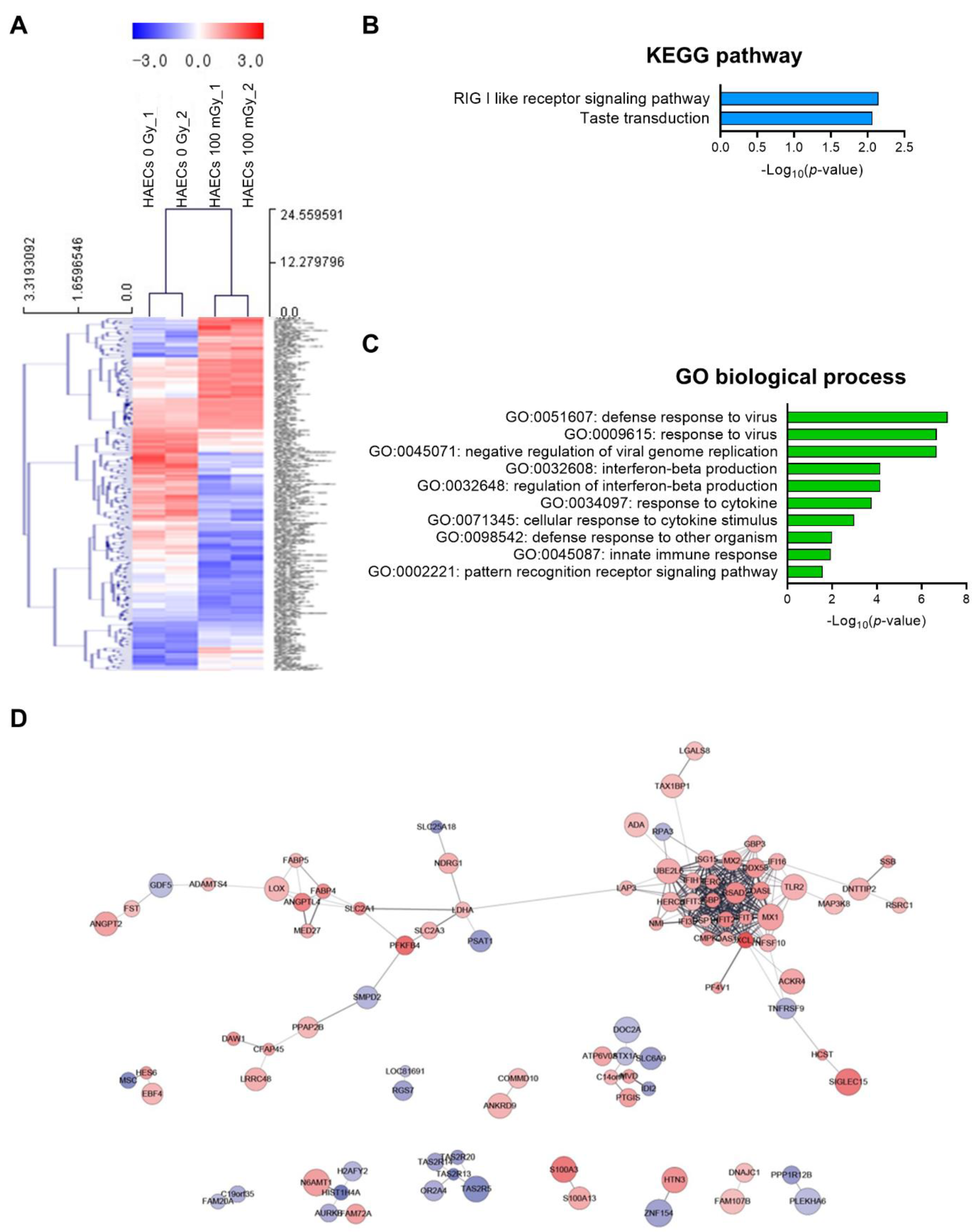
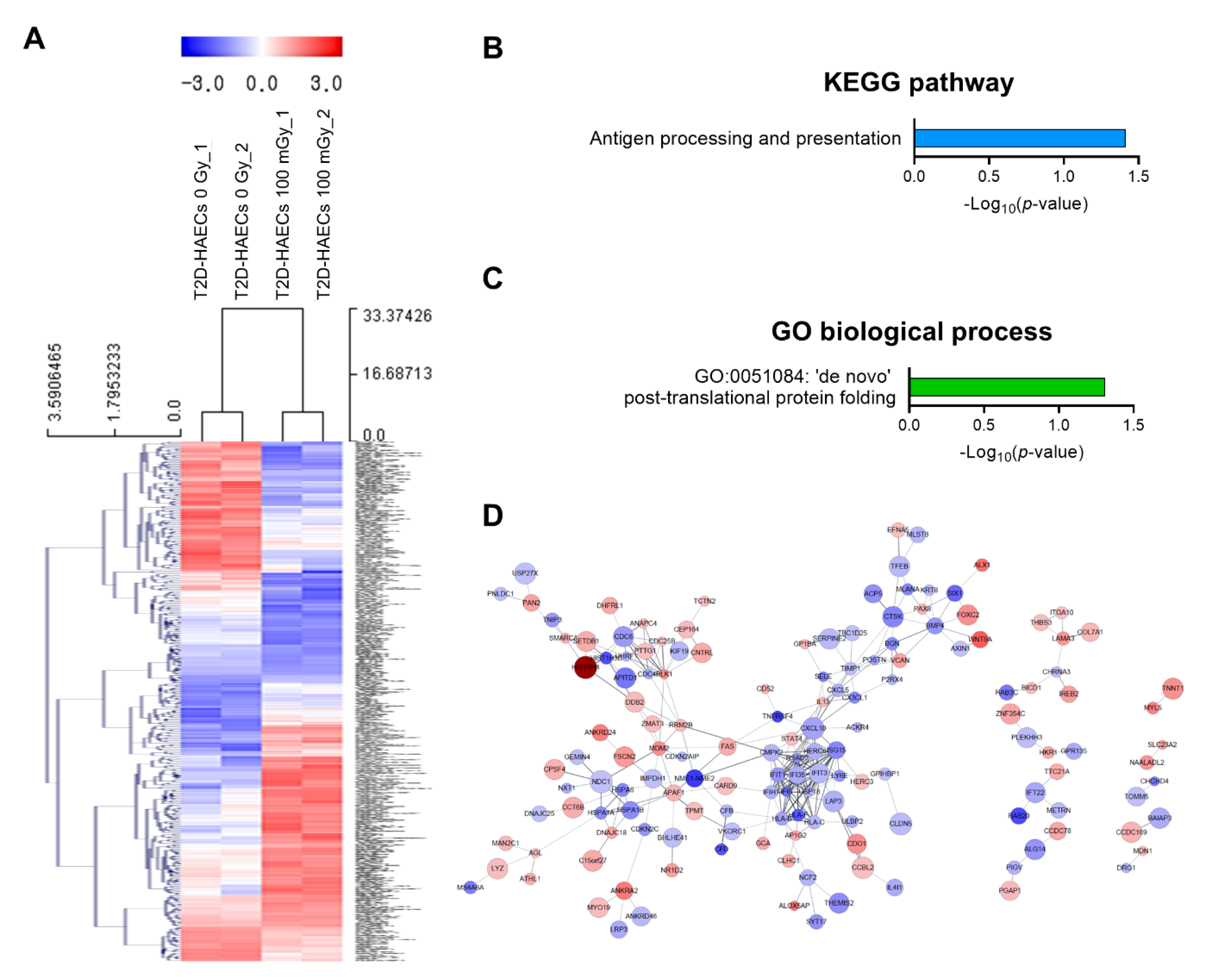
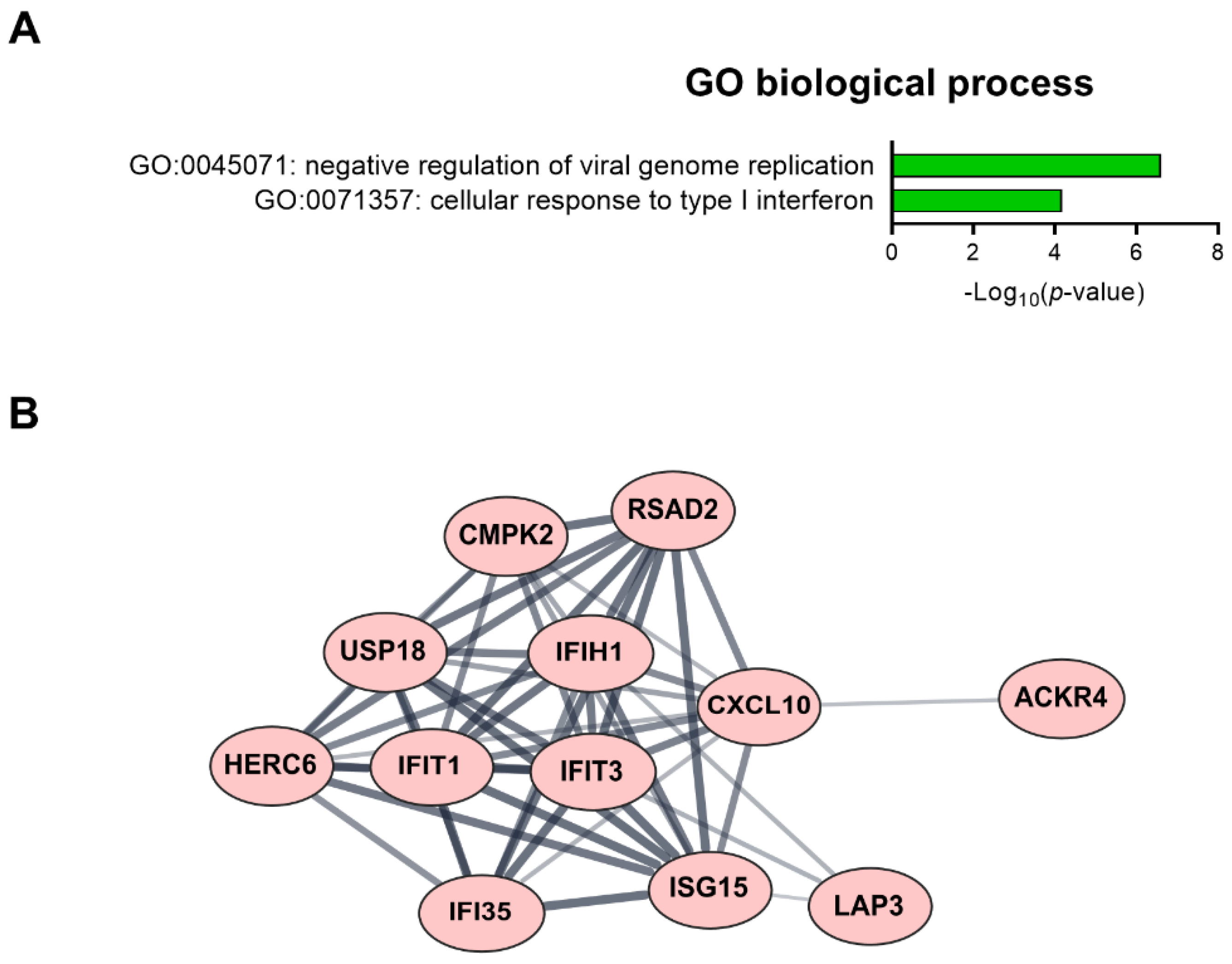

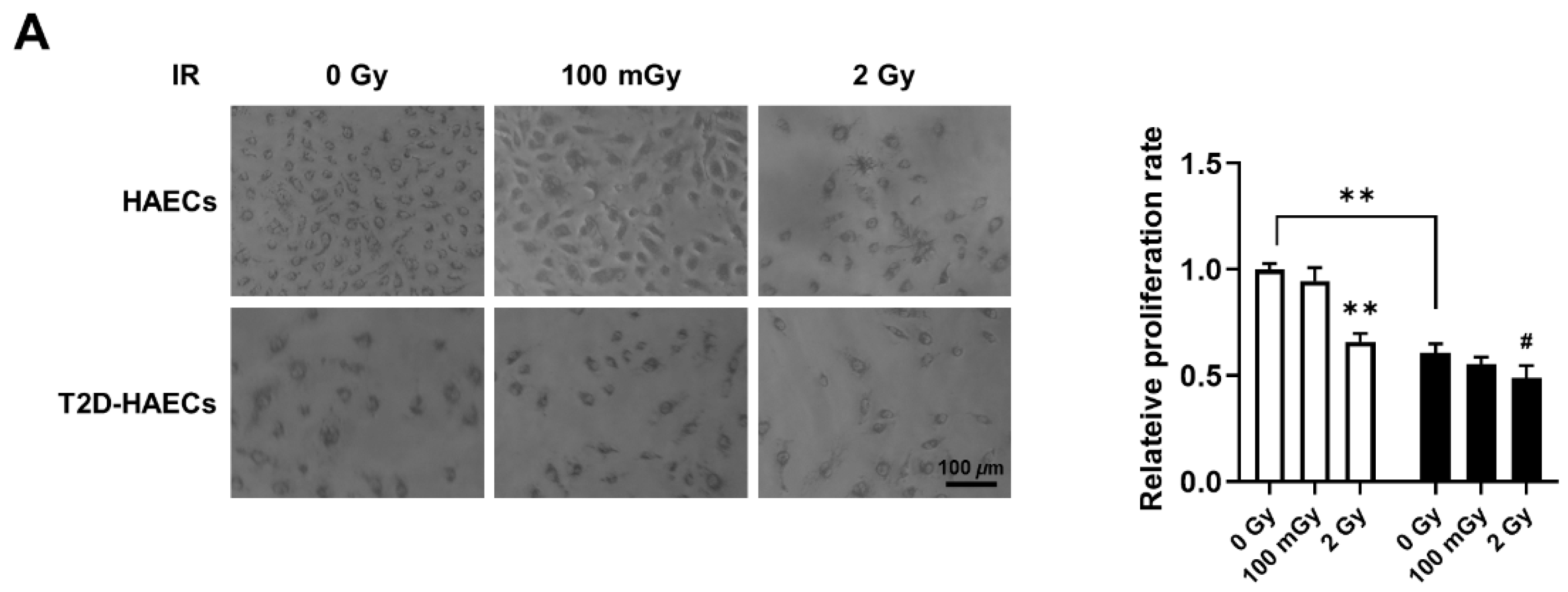
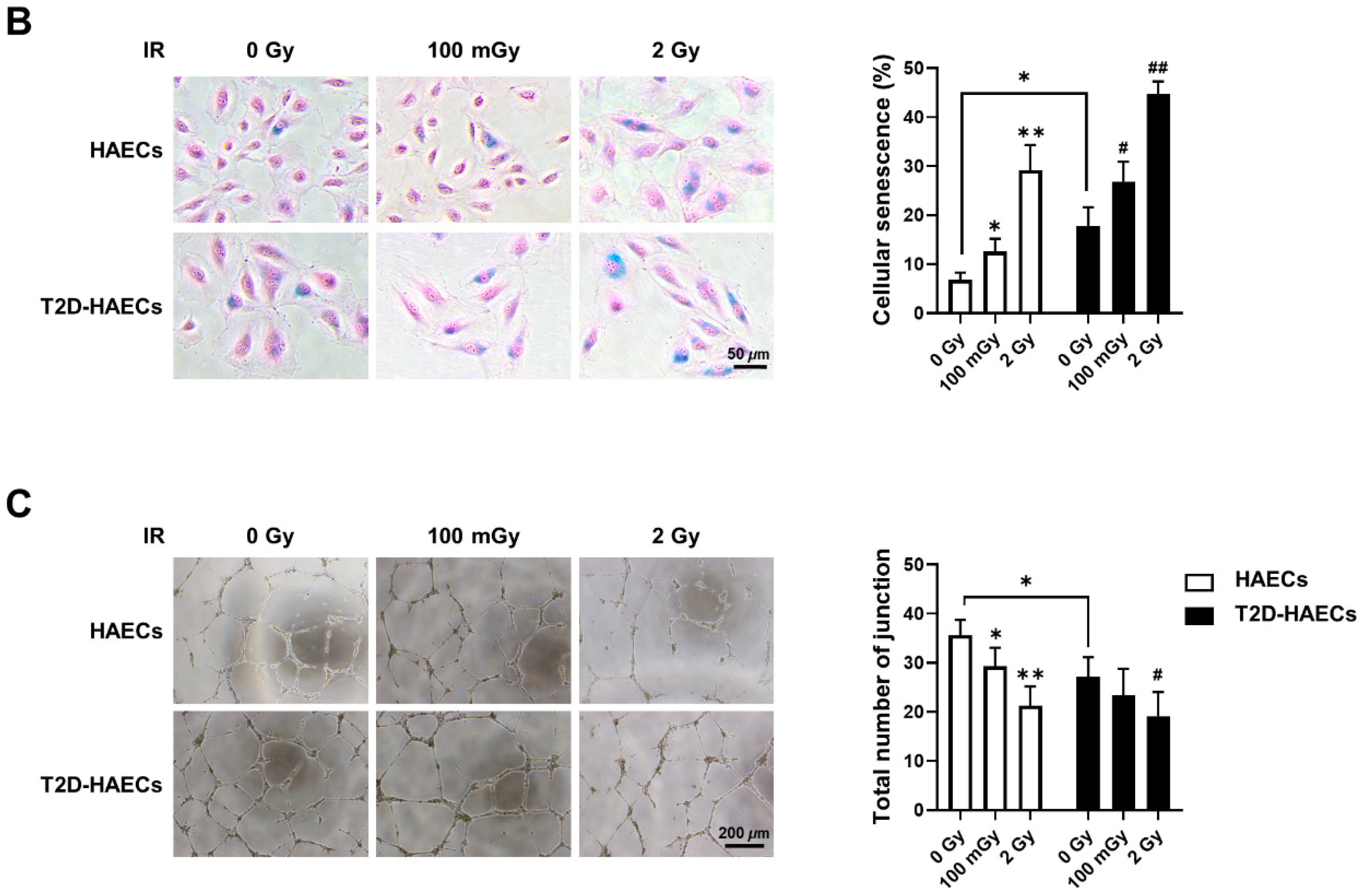
| Entrez_ID | Gene Symbol | Description | log2(fc) (p-Value) |
|---|---|---|---|
| 100529097 | RPL36A-HNRNPH2 | RPL36A-HNRNPH2 readthrough | −2.628 (0.034) |
| 5918 | RARRES1 | Retinoic acid receptor responder 1 | −0.812 (0.029) |
| 3627 | CXCL10 | C-X-C motif chemokine ligand 10 | 0.759 (0.014) |
| 255762 | PDZD9 | PDZ domain containing 9 | −0.750 (0.040) |
| 257177 | CFAP126 | Cilia and flagella associated protein 126 | −0.702 (0.009) |
| 5210 | PFKFB4 | 6-phosphofructo-2-kinase/fructose-2,6-biphosPhatase 4 | 0.658 (0.024) |
| 6781 | STC1 | Stanniocalcin 1 | 0.627 (0.011) |
| 164668 | APOBEC3H | Apolipoprotein B mRNA editing enzyme catalytic subunit 3H | −0.612 (0.019) |
| 284266 | SIGLEC15 | Sialic acid binding Ig-like lectin 15 | 0.602 (0.047) |
| 6274 | S100A3 | S100 calcium binding protein A3 | 0.597 (0.044) |
| 8359 | HIST1H4A | Histone cluster 1, H4a | −0.594 (0.012) |
| 50838 | TAS2R13 | Taste 2 receptor member 13 | −0.558 (0.002) |
| 116842 | LEAP2 | Liver expressed antimicrobial peptide 2 | −0.538 (0.049) |
| 6513 | SLC2A1 | Solute carrier family 2 member 1 | 0.532 (0.005) |
| 3433 | IFIT2 | Interferon-induced protein with tetratricopeptide repeats 2 | 0.531 (0.015) |
| 91543 | RSAD2 | Radical S-adenosyl methionine domain containing 2 | 0.516 (0.031) |
| 2633 | GBP1 | Guanylate binding protein 1 | 0.509 (0.011) |
| 54429 | TAS2R5 | Taste 2 receptor member 5 | −0.507 (0.045) |
| 2167 | FABP4 | Fatty acid binding protein 4 | 0.501 (0.011) |
| 9242 | MSC | Musculin | −0.498 (0.015) |
| Entrez _ID | Gene Symbol | Description | log2(fc) (p-Value) |
|---|---|---|---|
| 100526772 | TMEM110-MUSTN1 | TMEM110-MUSTN1 readthrough | 1.504 (0.043) |
| 121504 | HIST4H4 | Histone cluster 4, H4 | 1.403 (0.050) |
| 90273 | CEACAM21 | Carcinoembryonic antigen-related cell adhesion molecule 21 | −0.943 (0.001) |
| 574016 | CLLU1OS | Chronic lymphocytic leukemia up-regulated 1 opposite strand | −0.927 (0.029) |
| 117608 | ZNF354B | Zinc finger protein 354B | 0.919 (0.016) |
| 654364 | NME1-NME2 | NME1-NME2 readthrough | −0.912 (0.032) |
| 7293 | TNFRSF4 | Tumor necrosis factor receptor superfamily member 4 | −0.882 (0.008) |
| 4050 | LTB | Lymphotoxin beta | −0.839 (0.013) |
| 55647 | RAB20 | RAB20, member RAS oncogene family | −0.839 (0.028) |
| 8351 | HIST1H3D | Histone cluster 1, H3d | −0.809 (0.012) |
| 1675 | CFD | Complement factor D | −0.797 (0.009) |
| 3134 | HLA-F | Major histocompatibility complex, class I, F | −0.777 (0.011) |
| 7483 | WNT9A | Wnt family member 9A | 0.758 (0.028) |
| 6495 | SIX1 | SIX homeobox 1 | −0.700 (0.027) |
| 8092 | ALX1 | ALX homeobox 1 | 0.660 (0.014) |
| 374879 | ZNF699 | Zinc finger protein 699 | 0.658 (0.013) |
| 11092 | SPACA9 | Sperm acrosome associated 9 | −0.651 (0.005) |
| 2537 | IFI6 | Interferon alpha inducible protein 6 | −0.642 (0.000) |
| 241 | ALOX5AP | Arachidonate 5-lipoxygenase activating protein | 0.633 (0.001) |
| 100288332 | NPIPA5 | Nuclear pore complex interacting protein family member A5 | 0.622 (0.026) |
| Entrez _ID | Gene Symbol | log2(fc) (p-Value) | |
|---|---|---|---|
| HAECs | T2D-HAECs | ||
| 51554 | ACKR4 | 0.375 (0.042) | −0.333 (0.003) |
| 28990 | ASTE1 | −0.269 (0.006) | −0.285 (0.031) |
| 129607 | CMPK2 | 0.430 (0.009) | −0.333 (0.029) |
| 3430 | CXCL10 | 0.795 (0.014) | −0.405 (0.048) |
| 55008 | HERC6 | 0.347 (0.025) | −0.340 (0.028) |
| 64135 | IFI35 | 0.403 (0.002) | −0.358 (0.032) |
| 3434 | IFIH1 | 0.367 (0.016) | −0.329 (0.015) |
| 9636 | IFIT1 | 0.427 (0.009) | −0.468 (0.020) |
| 3437 | IFIT3 | 0.297 (0.019) | −0.304 (0.040) |
| 51056 | ISG15 | 0.357 (0.021) | −0.544 (0.030) |
| 91543 | LAP3 | 0.308 (0.010) | −0.347 (0.045) |
| 11274 | RSAD2 | 0.516 (0.031) | −0.490 (0.001) |
| 50838 | TAS2R13 | −0.559 (0.002) | −0.529 (0.009) |
| 259295 | TAS2R20 | −0.438 (0.009) | 0.497 (0.003) |
| 3627 | USP18 | 0.277 (0.004) | −0.346 (0.001) |
| Gene Symbol | Forward Sequence | Reverse Sequence |
|---|---|---|
| ACKR4 | CCCGCTACCTAGGAACATCA | TCTATGGCTCGGCAGAACTT |
| CMPK2 | CTGAGGAGAGGTTGCAGAGG | CTGCAGGACCTTTTCTCTGG |
| CXCL10 | CTGTACGCTGTACCTGCATCA | TTCTTGATGGCCTTCGATTC |
| IFI35 | CCATTTTCAGTGCCCAAGAT | TTGATCGTGTGCTCCTTTTG |
| IFIH1 | ACCAAATACAGGAGCCATGC | GCGATTTCCTTCTTTTGCAG |
| IFIT1 | AAAAGCCCACATTTGAGGTG | GAAATTCCTGAAACCGACCA |
| ISG15 | TGTCGGTGTCAGAGCTGAAG | GCCCTTGTTATTCCTCACCA |
| LAP3 | TTTGCTTCTGGGCAGAACTT | CTTTGGCCACACTGAGGAAT |
| RSAD2 | CTCGCCAGTGCAACTACAAA | CACCAACTTGCCCAGGTATT |
| USP18 | CTGTGCCATGGAGAGTAGCA | AGGTGGATTGTCAGGGTCTG |
Publisher’s Note: MDPI stays neutral with regard to jurisdictional claims in published maps and institutional affiliations. |
© 2022 by the authors. Licensee MDPI, Basel, Switzerland. This article is an open access article distributed under the terms and conditions of the Creative Commons Attribution (CC BY) license (https://creativecommons.org/licenses/by/4.0/).
Share and Cite
Lee, S.-H.; Jeong, Y.J.; Park, J.; Kim, H.-Y.; Son, Y.; Kim, K.S.; Lee, H.-J. Low-Dose Radiation Affects Cardiovascular Disease Risk in Human Aortic Endothelial Cells by Altering Gene Expression under Normal and Diabetic Conditions. Int. J. Mol. Sci. 2022, 23, 8577. https://doi.org/10.3390/ijms23158577
Lee S-H, Jeong YJ, Park J, Kim H-Y, Son Y, Kim KS, Lee H-J. Low-Dose Radiation Affects Cardiovascular Disease Risk in Human Aortic Endothelial Cells by Altering Gene Expression under Normal and Diabetic Conditions. International Journal of Molecular Sciences. 2022; 23(15):8577. https://doi.org/10.3390/ijms23158577
Chicago/Turabian StyleLee, Soo-Ho, Ye Ji Jeong, Jeongwoo Park, Hyun-Yong Kim, Yeonghoon Son, Kwang Seok Kim, and Hae-June Lee. 2022. "Low-Dose Radiation Affects Cardiovascular Disease Risk in Human Aortic Endothelial Cells by Altering Gene Expression under Normal and Diabetic Conditions" International Journal of Molecular Sciences 23, no. 15: 8577. https://doi.org/10.3390/ijms23158577
APA StyleLee, S.-H., Jeong, Y. J., Park, J., Kim, H.-Y., Son, Y., Kim, K. S., & Lee, H.-J. (2022). Low-Dose Radiation Affects Cardiovascular Disease Risk in Human Aortic Endothelial Cells by Altering Gene Expression under Normal and Diabetic Conditions. International Journal of Molecular Sciences, 23(15), 8577. https://doi.org/10.3390/ijms23158577






